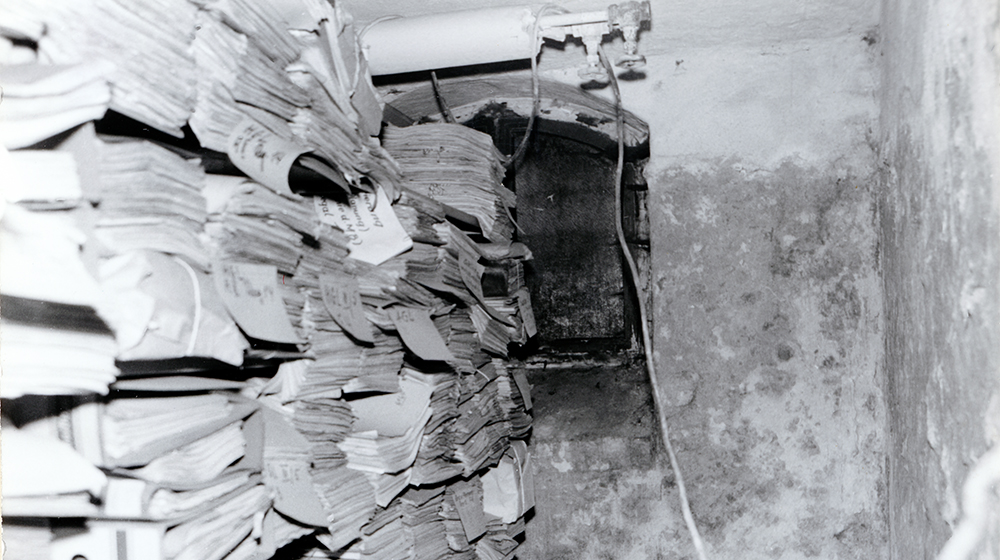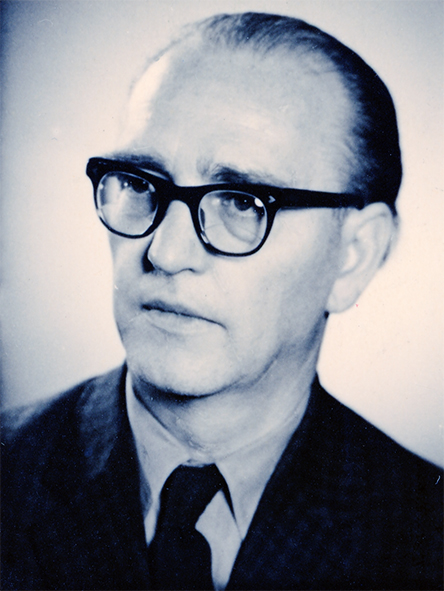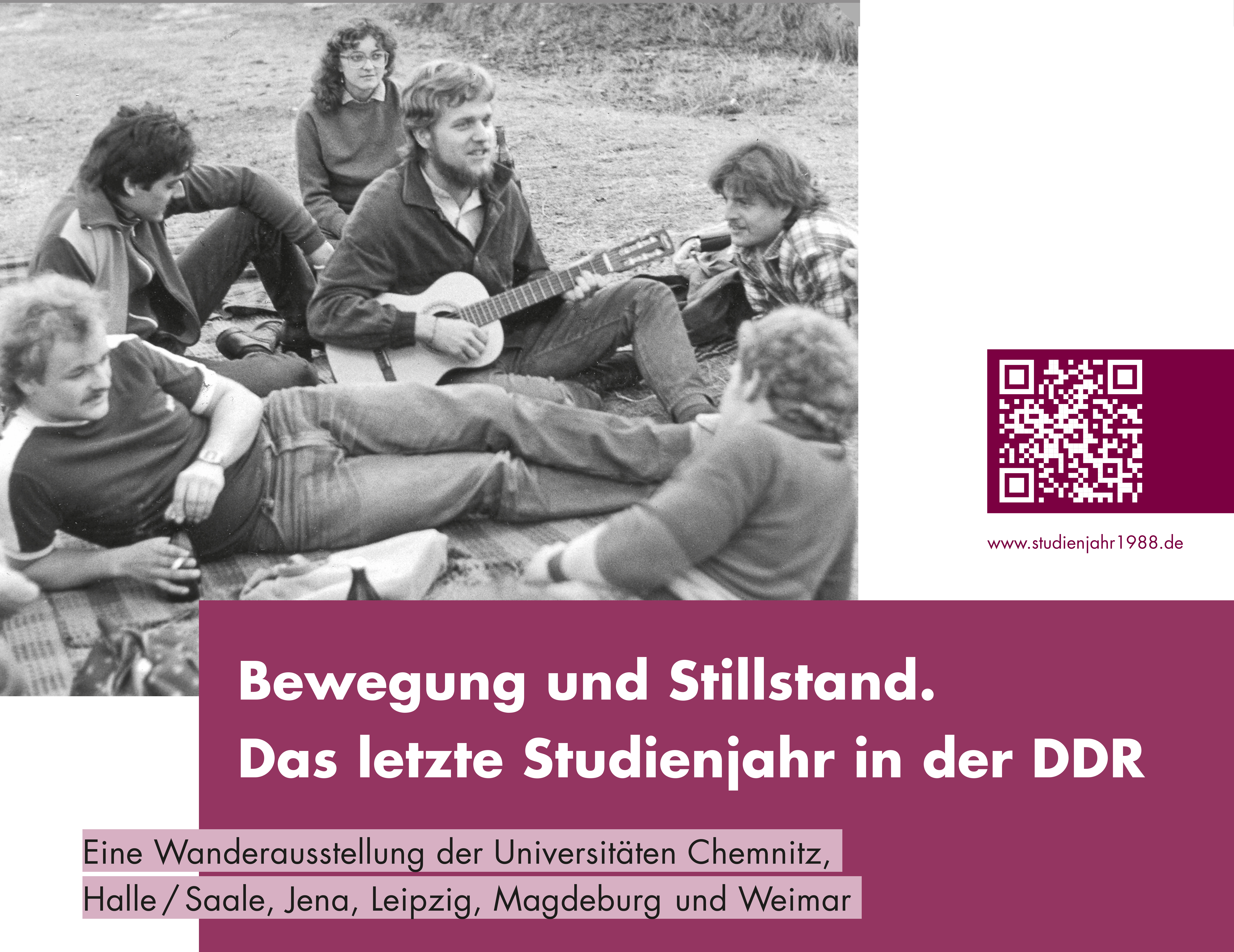The future needs the past
The university archive was founded 65 years ago
From dusty basement rooms to a digital treasure trove full of stories: for 65 years, the university archive at Otto von Guericke University Magdeburg has been preserving memories, documents, and bequests that shape the identity of the university. A look back reveals how a living memory of the university has grown from modest beginnings. A look ahead shows the challenges facing the archive in the age of digitalization.
Just seven years after the University of Heavy Machinery Engineering was founded in 1953, the first shelves for an “archive” were set up in the basement of the rectorate building at Falkenbergstraße 9. This was based on the order to establish administrative archives dated March 31, 1960. However, what began there in modest rooms was far from professional operation: the management of the documents was nothing more than a secondary task that was carried out by employees without archival training. The documents were stored under difficult conditions and were often only provisionally secured.

The magazine of the first archive in the rectorate building from the 1960s;
Photo: OVGU Archive: B 747
“The move to Residence Hall 7 in 1976 marked the beginning of a new chapter for the archive,” emphasizes Camen Schäfer, head of the university archive. "For the first time, the files could now be stored in a manner appropriate for archiving. At the same time, the role of the archive changed fundamentally: it evolved from a secondary activity into an independent institution with professionally qualified staff. Archivists and archive assistants—up to four people at a time—began to systematically catalog the documents. They introduced filing systems, created card indexes, and compiled finding aids."

Ms. Struy headed the archive from the mid-1970s and worked in the magazine of the 7 dormitory, among other places.
Photo: OVGU Archive: B 747
Reunification marked the beginning of a new era for the university and also for the archive. In 1993, the Erich Weinert College of Education, Otto von Guericke Technical University, and the Medical Academy merged to form what is now Otto von Guericke University Magdeburg. "For the archive, this step meant a significant expansion of its responsibilities: The holdings of the University of Education were transferred to the existing university archive, while the documents of the Medical Academy remained in the hospital as a branch office, but are now also managed by the university archive," explains Carmen Schäfer. With the expansion of the archive holdings, new shelving systems were purchased. Gradually, modern computer technology was also introduced, which made research noticeably easier. But despite the new shelving systems, one fundamental problem remained: too many files and too little space. A new location for the archive became inevitable. The archive found it in Building 18. Not only is there sufficient space for the archive materials there, but also office space for the staff.
Extensive holdings and valuable bequests
Today, the university archive comprises around 3,500 linear meters of files, with around 200 meters being added each year. These include extensive student, personnel, and doctoral files, which are constantly growing. 173,000 entries have already been digitally recorded, which makes research much easier.
The holdings are divided into an administrative archive and a final archive. The latter currently contains around 7,000 particularly valuable files with official documents.
Whereas it used to be dusty basement rooms, digitization now presents challenges for archive staff. “Today, correspondence is mainly handled by email or other electronic communication platforms. However, analog and digital work often still take place simultaneously,” says archive employee Sandra Schleinitz, describing the problem. Systematic filing of both types of files is only patchy. Preparing them for proper storage in the archive will greatly determine the work of archivists in the future.
“Special attention is being paid to the creation of a digital photo archive. Many historical photographs are unlabeled, which is why the support of contemporary witnesses is welcome in order to uncover the stories behind the images,” emphasizes Sandra Schleinitz. In addition, the archive preserves important estates—writings and documents from researchers and teachers whose contributions to the scientific history of the university are invaluable, such as those of Ernst Schiebold, Alfons Kauffeldt, and Carl Justus Heckmann.

Prof. Dr. phil. Ernst Schiebold (1894–1963) was one of the most prominent scientists of his time and made a significant contribution to the fields of crystallography, metal physics, and materials testing. As a pioneer in radiological materials testing, he also made significant contributions to the development of Magdeburg University. In his memory, the Ernst Schiebold Visiting Professorship was established at Magdeburg University of Technology in 1984, and in 1996 the German Society for Non-Destructive Testing donated the “Schiebold Memorial Coin.” Building 50 on Große Steinernetischstraße now bears his name and, as the Ernst Schiebold Building, is a visible sign of his scientific legacy.

Prof. Dr. phil. habil. Alfons Kauffeldt (1906–1982) conducted significant research on Otto von Guericke, which culminated in his successfully defended habilitation thesis “On the Philosophical Work of Otto von Guericke” in 1964. The results of this work were published in 1968 in the book “Otto von Guericke – Philosophisches über den leeren Raum” (Otto von Guericke – Philosophical Thoughts on Empty Space), which was made available to a wide audience and has been reprinted several times. This work can be considered the pinnacle of his scientific career and brought him international recognition. Kauffeldt received the GDR Literature Prize for his book “Nikolaus Kopernikus – der Umsturz des mittelalterlichen Weltbildes” (Nikolaus Copernicus – The Overthrow of the Medieval Worldview) (1954). He was a professor of the history of technology and natural sciences at the Technical University of Magdeburg.

On the occasion of his 110th birthday, Dr. Michael Heckmann donated the estate of his father, Prof. Dr.-Ing. Carl Justus Heckmann (1902–1993), to Otto von Guericke University Magdeburg. Heckmann was an entrepreneur, design engineer, and university professor who worked from 1956 to 1967 at the University of Heavy Machinery Engineering and the Otto von Guericke Technical University, the predecessor institutions of today's Otto von Guericke University Magdeburg. Packed in boxes, 4.5 linear meters of files were handed over, including 120-year-old company catalogs, ten photo albums, documents relating to 128 seminars that Heckmann held during his eleven years of teaching, manuscripts for 97 lectures, and 46 publications with handwritten notes.
From conferences to traveling exhibitions
The University Archives is actively involved in researching and communicating the history of the university and has organized numerous exhibitions over the years. In March 2023, it hosted the spring conference of Section 8 of the Association of German Archivists. More than 70 colleagues discussed new approaches to public relations.
A particular highlight was the opening of the traveling exhibition “Movement and Standstill: The Last Year of Study in the GDR” on October 15, 2024, in cooperation with the universities of Chemnitz, Halle/Saale, Jena, Leipzig, and Weimar. Numerous guests from politics and academia attended. The exhibition highlights the experiences and challenges that students encountered during this formative phase of German history. Archivists from the Technical University of Prague will present the exhibition in October 2026 during enrollment, thus incorporating international perspectives.

Excerpt from the exhibition poster “Movement and Standstill. The Last Year of Study in the GDR”
Poster: University Archive
With the ongoing digitization of student and personnel files and the increase in digital documents, university archives are facing major challenges. “The immense volume of digital documents requires not only innovative solutions, but also close cooperation between the university archives in Saxony-Anhalt,” says Carmen Schäfer. “In order to find joint solutions, our university archive organized a network meeting of Saxony-Anhalt's university archives at the end of August 2025. In 2026, we will continue to be committed to expanding a network or working group for Saxony-Anhalt's university archives.”
Today, the university archive symbolizes more than just the storage of old files. It is both the memory and showcase of the university, a place where history comes alive. What once began in the basement has long since become a foundation of institutional identity.
Text:
CARMEN SCHÄFER; Certified archivist and head of the university archives
SANDRA SCHLEINITZ; University Archives employee